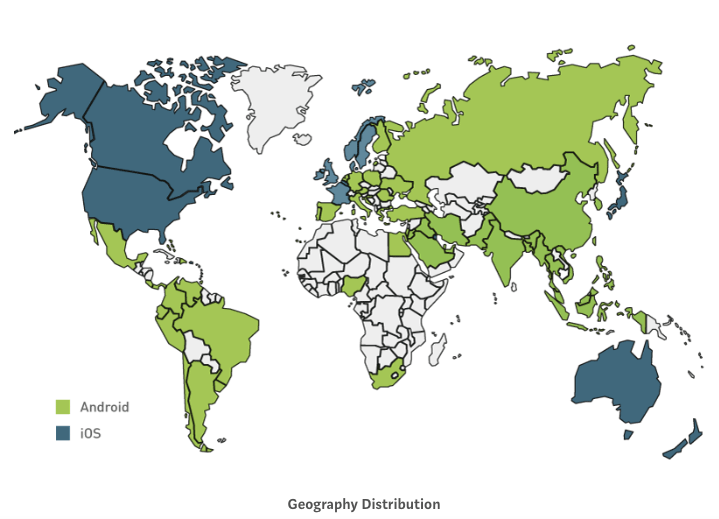Some of the best technologies available today were born from unique software application ideas. Great apps not only solve real problems but their creators may even become billionaires.
However, if poorly executed, your investment in a genius mobile app idea can quickly turn into a huge bank debt.
There are certain processes and trends you must keep abreast of if you want to successfully turn your app idea into reality. From market research to app design, development, and monetization, you’ll need to apply the industry’s best practices to ensure success.
We’ve put together some pro tips for turning your mobile app idea into reality.
1. Define your app idea and the features you want
Every good app starts with the spark of an idea. But to set that thought into motion and turn it into a genuine product, the first thing you need to do is define the app idea. In other words —put it on paper! Even if the paper is electronic.
To get the ball rolling, first draw up a Product Requirement Document.
A Product Requirement Document (PRD) is essentially a written document that clearly defines the vision, purpose, and specifications or features of a software application. This document guides the development team(s) through the course of the project.
Product requirement documentation usually includes different elements of the project like business requirements, the goals you have in mind for your app, user personas and so on. If you want to turn your app idea into a functional product, detailed PRD is essential.
Making a feature list is a crucial step when defining your app idea.
The overall success of your app depends on its features and how well they work together to deliver a top-notch user experience (UX).
Your feature list will generally vary from product to product, depending on the app objectives. However, certain features are must-haves for modern apps.
Here are some of them:
- Search
- Social media integration
- Multi-platform compatibility
- Offline usability
- User feedback
- Responsive design for multiple screen sizes
With a finished feature list, your app idea will look more workable to all the technical teams involved.
2. Research market trends (and update your feature list)
More often than not, your initial feature list will require some modification. The main metric used to measure your app’s success is customer satisfaction. It’s almost impossible to satisfy your app users without understanding fast-changing market trends.
Market research is an indispensable part of the app development process and it answers several key questions that are vital to your app’s success, such as:
- Is your app needed? If yes, who’s the target audience?
- Who are your competitors? What can you learn from them?
- How do you market and monetize your app effectively?
Market research most often starts with defining your target audience and this process includes accurately categorizing your app, defining its objectives, studying user demographics, the types of devices they use, their geographical location etc.
After completing your initial market research it’s vital to study the prevalent consumer trends to ensure your results are accurate.
Studying these categories will help you better understand your customers’ needs.
For example, latest trends show that around half of mobile device usage time is spent on social apps
With 9.5 billion social app downloads in 2019 alone, it’s imperative to integrate social features into your app in order to get as much engagement as possible.
Updating your initial feature list with insights gained from well-executed market research will boost your app’s chances of success in the market.
3. Identify the users/audience for your app
To meet your users’ expectations and achieve a high level of customer satisfaction, you need to have a deep understanding of the average consumer’s wants and needs.
As mentioned previously, your average user is first defined by common demographic information such as location, age, language, gender, occupation, education etc. More often than not, however, more in-depth user research is needed to accurately identify your target audience.
Here are some steps we recommend for conducting effective user research:
- Establish your app’s target market segment and choose between individual or corporate customers (B2B or B2C).
- Define the customers’ user persona (based on the above-listed demographics, needs, core values, etc.)
- Identify the major challenges facing your target audience and document ways in which your app can help.
- Find out incentives that would attract potential users to use your app.
- Create a clear-cut plan on how your app will leverage all your research results.
Though they may appear straight to the point, following the five steps above can be rather tricky.
To ensure accurate results, you can either adopt a field study approach or journal approach.
The field study approach generally involves users interacting with a prototype of your app while the journal approach focuses on feedback from users of similar existing apps.
4. Pick a platform
The mobile app development space is dominated by the two main operating systems (OS), iOS and Android, with a combined market share of 99.3% of all mobile devices.
The choice between the two market leaders comes down to your understanding of your target audience.
Your target audience’s geographical location is a big factor you need to take into consideration.
The above map shows that iOS usage is more prevalent in the United States, Canada, Western Europe, Australia, and Japan.
Android, on the other hand, has an advantage in Central and South America, India, China, Africa, the Middle East, Russia and the rest of Europe. This mobile OS usage distribution gives us an insight into what platform you should prioritize depending on your potential consumers’ location.
Beyond location, other influential variables include user behavior, app features, design, device support, monetization, and budget. Each of these factors will influence your choice of platform in different ways.
For example, there are more than 24,000 distinct Android devices on the market in 2020 (including smartphones, tablets, TV sticks, etc.) while iOS is a closed platform which supports far fewer devices than Android.
5. Identify your monetization strategy
Once you understand your users and recognize how to deliver the functionality they need, you need to put together a monetization strategy.
After all, you need revenue to keep your app (and your entire business!) afloat.
The mobile app space is a large market with revenues of over $581.9 billion in 2020. This figure is projected to hit the $582 billion mark by the end of 2020. In that size industry, there are several established app monetization strategies.
Here’s a list of the major app monetization strategies and their estimated revenue generation shares:
- In-app advertising (31%): Although often heavily criticized by users, no other method has proven as financially fruitful as in-app adverts. Apps often launch with banner ads, affiliate ads, native ads, reward ads, interstitials, etc.
- In-app purchases (16%): This strategy is especially popular in the gaming industry. Users can either purchase special app features and virtual goods or trade fiat currency for in-app currency.
- Subscriptions and freemium model (14%): Most mobile apps allow you access to their content only after paying for a subscription (preferably after a free trial period). On the other hand, the freemium model restricts access to premium features unavailable on the free version.
- Transactional/network/affiliate models (10%): Companies such as Uber, Airbnb, Escrow, or Upwork use this approach. They charge a commission for facilitating the delivery of goods and services, and financial transactions.
Your choice of monetization strategy will depend on the purpose of your app, your target users, and the best practices in your industry.
6. Design a flowchart for your app
Once you’ve figured out the best strategy for monetizing your app, the next step is designing a flowchart.
A flowchart is a diagram that illustrates the sequence app users should follow to execute a task or navigate your product.
Product engineers and designers utilize UX flowcharts to determine the ideal tools for reproducing the desired interfaces in advance. Flowchart diagrams can be so detailed as to include each tab, icon, and every click/swipe behavior possible.
Of course, creating an effective user flowchart begins with understanding the consumer. Your user research results come in handy here. Another piece of information useful for efficient flowchart design is the app’s traffic source.
The knowledge of your users’ goals will allow you to visualize how your app can help them achieve these goals in the fastest, most satisfying manner possible. Now, go ahead and create a flowchart prototype, then test and review it appropriately.
Common flowchart design best practices include adhering to the optimal UX/UI design principles, keeping the entire design on one page, prioritizing accessibility, etc.
There are numerous flowchart software tools you could use to create a good flow chart. The Google Drawings software quickly comes to mind because it’s free and easy to use.
7. Create a wireframe for your app
The process of visually conceptualizing your app’s design doesn’t end with the user flow chart. The app wireframe is equally important. It’s rather common for app wireframes to be confused with user flow charts.
While a flow chart focuses on how the user navigates through your app’s pages, the wireframe explores the various possibilities of designing a single page.
Because it is less concerned with transition, it is more static. A wireframe will include every detail about the placement of buttons, text, and images on a page.
A good wireframe helps you figure out beforehand how the product will help the users. It also serves as a clear reviewable blueprint of your app and helps avoid common mistakes in the development process, saving you a lot of time and money.
The process of preparing an app wireframe varies from team to team. Here’s an example of the steps you’ll need to take when building a wireframe:
- Create a content spreadsheet. This contains all the necessary features and content ordered by priority.
- Design a basic screen sketch where the screens are marked with designated content blocks.
- Develop a detailed wireframe. Zones that were initially marked are now filled with different content types such as icons, image/video placeholders, etc.
- Review the wireframe with the client or other professionals.
Although wireframes are important for turning your app idea into reality, avoid spending too much time on their development so as not to prolong the development process.
8. Create a brand and identity for your app
With tons of Android and iOS apps out there, you’ll need to do an excellent job to make yours stand out
While functionality is key in setting up an app for success, it may not be enough to achieve your desired results.
This is where app branding comes in.
If you want your app to be the next big thing in the market, you must create and communicate a memorable image to the users.
In modern-day digital marketing, a good branding strategy is all about personalization. Your app branding should focus on delivering an experience that’s both attractive and relatable to your target audience.
When it comes to branding strategy, your objectives need to be creating and sustaining brand awareness, loyalty, and consistency. To achieve all three, pay close attention to the user experience from a branding perspective.
The major elements of your app that communicate a sense of identity include the logo, app icons, app name, landing page (design and text), calls to action (CTAs), integrated customer services, etc.
When creating or updating these features, consider the emotions they evoke in your users and whether or not they amplify your app’s major selling points.
Choosing the name of your app
Choosing a name for your app is one of the most important app branding decisions you’ll have to make. There’s a big debate around app naming that focuses on the inclusion of keywords.
Adding keywords to your app name is generally an easy way to optimize your app and make sure you rank well.
This applies to both the Apple App Store and the Google Play Store. It’s a double-edged sword, however, as cluttering the name of your app with keywords could backfire as users generally associate that with low-quality apps.
Essentially, if you’re determined to include keywords in your app’s name, make sure you’re doing it right. Do extensive keyword research and analyze the top competitors in your industry. Besides these, some other tips you should consider are:
- Ensure that the name reflects the main features of your app.
- Make it short and memorable.
- You can use wordplay to make the name stand out. 31% of consumers download an app because its name sounds “interesting”.
- Use a name that corresponds with your domain.
There’s no universal approach to app naming. However, using the tips above can help you attract organic traffic and build a strong brand.
9. Find the perfect development partner and estimate the costs
After laying most of the groundwork, it’s time to collaborate with mobile app development experts. Finding the right development partner is a make-or-break step in your app development journey.
In your search for the right partner, the two indicators that should guide your choice are expertise and transparency. Real industry experience shows that hiring a specialized agency is the most reliable method to ensure you get both on your project.
Aside from worrying about if your chosen partners will get the job done to your satisfaction, one other area of concern when hiring a development partner is the fear of overpaying for their services.
Generally, when negotiating a project, the developer and the client can agree to a fixed price (based on requirements and targets) or time & material model.
Today, the time & material model has emerged as the most transparent option. Modern management software solutions allow clients to document every hour spent on each project task or process.
You can check out our article on how to hire a mobile app developer for more tips on this process.
Complete the UX/UI
One part of estimating the cost of your app development project that deserves a special mention is the UX/UI design.
If you’re partnering with freelancers, you’ll usually need to hire a designer independent of the developer. This often means increased costs and more difficult logistics.
Even if you find a developer with design skills, you may still have to cope with serious quality risks.
However, a development agency can save you your time and money. A good agency will have an experienced team of developers, designers, project managers and other experts necessary to turn your app idea into a finished product.
Once you find the right agency, consult them about your app branding and design. After this, they can go on to develop the user flow chart and app wireframe. On completion, you can have them execute the final UX/UI design of the app.
It makes a lot of business sense to reevaluate your initial invoice and development plan with the agency once the app’s visual design is ready. Considering how critical UX/UI design is, it’s quite common for costs and timeframes to change significantly.
10. Test the beta version first
If you’ve reached this stage—well done! That means your development project is getting closer to delivering the final product!
Just before you launch your app, you’ll need to beta test it to discover and fix any possible issues or bugs.
The last thing you want to do is give your users a bad first impression. It’s normal for initial versions of an app to contain bugs but some critical issues can make it difficult or even impossible for an app to make a comeback.
The idea behind beta testing is to get a large number of people (beta testers) to use your app consistently over an extended period and generate feedback about their experience.
All of this happens before the major release of the app.
There are a number of mobile beta-testing platforms out there. Some of the most popular ones include TestFlight (official iOS), Google Play Console (official Android), TestFairy, Testmagic, BetaTesters, Erli Bird, etc.
On these platforms, you can choose between technical, marketing, or random testers.
You must define your testing goals with precision if you wish to achieve your desired results. Here are some good questions to help guide you through the app testing process:
- How many testers do you need?
- What type of feedback do you want?
- What’s the testing time frame?
An easy way of motivating testers is offering them incentives such as gift cards, in-app currency, or even the product itself. Whatever you choose, make sure you’re getting only the most detailed and helpful feedback from your testers.
11. Launch the app and start marketing
At long last, your app is now ready to hit the market. The success of your launch day will greatly depend on the groundwork you’ve done beforehand (preferably three months ahead).
Preparing the launch of your app involves using all the knowledge you’ve gained during the app development process: market research (target audience identification), keyword research, branding, etc.
You need to apply that knowledge to build your app’s online presence. Register a domain, create a landing page, and use targeted content to gather an email subscribers’ list. Articles, banner ads, and other forms of content will also come in handy here.
On D-day, submit your mobile app to your chosen app store(s). Once the app is up and running, spread the word to all the contacts on your email list!
Next, you need to set your post-launch marketing strategy in motion. There are several ways to go about this.
Depending on your industry or budget, you can launch social media, pay-per-click (PPC), or email ad campaigns. Industry influencers are also an option.
However, you don’t need an oversized budget for your app to stand a chance of succeeding. You can promote your app organically by optimizing it for the app store(s) and search engines and sharing it on social media or company websites/blogs.
12. Write down your reviews for further improvement
If you’ve properly implemented all the tips shared in this article, your app should be off to a great start.
However, if you want to secure long-lasting success, you need to leverage user reviews. To ensure high retention rates, it’s important to build a system for collecting, analyzing, and implementing user feedback.
To collect user feedback effectively, you first have to request it. And with feedback requests, timing is key!
There are three gateways where you should be requesting reviews from your users:
- during onboarding
- during the regular usage
- while offboarding
Most app owners focus only on the last two gateways.
The truth is a good percentage of your app downloaders never become regular users. You can integrate certain data fields natively into the sign-up process that can reveal their reason for abandonment.
Once you’ve gathered the reviews, break your users into segments based on specific behaviors, usage time, and other attributes. Analyze the feedback and implement the key points in future updates.
Finally, you should reply to public reviews (especially negative ones) and let them know you’ve heard them.
Conclusion
Without a doubt, the road to turning your mobile app idea into reality is often a long and rocky one. But with the right strategy, you can save a lot of time and energy, and achieve brilliant results.
To sum up, here are some of the major components of the app development process you must pay attention to:
- Feature list compilation;
- Extensive market research (audience identification, branding, etc.);
- App design (user flowchart, wireframe, etc.);
- Developer recruitment;
- Beta testing and launch and;
- Marketing and app monetization.
Nowadays, mobile apps are an integral part of our daily lives. We’re confident that you want your idea to become the next big thing helping people around the world improve their lives for the better. We hope this article has inched you closer to achieving that dream.




